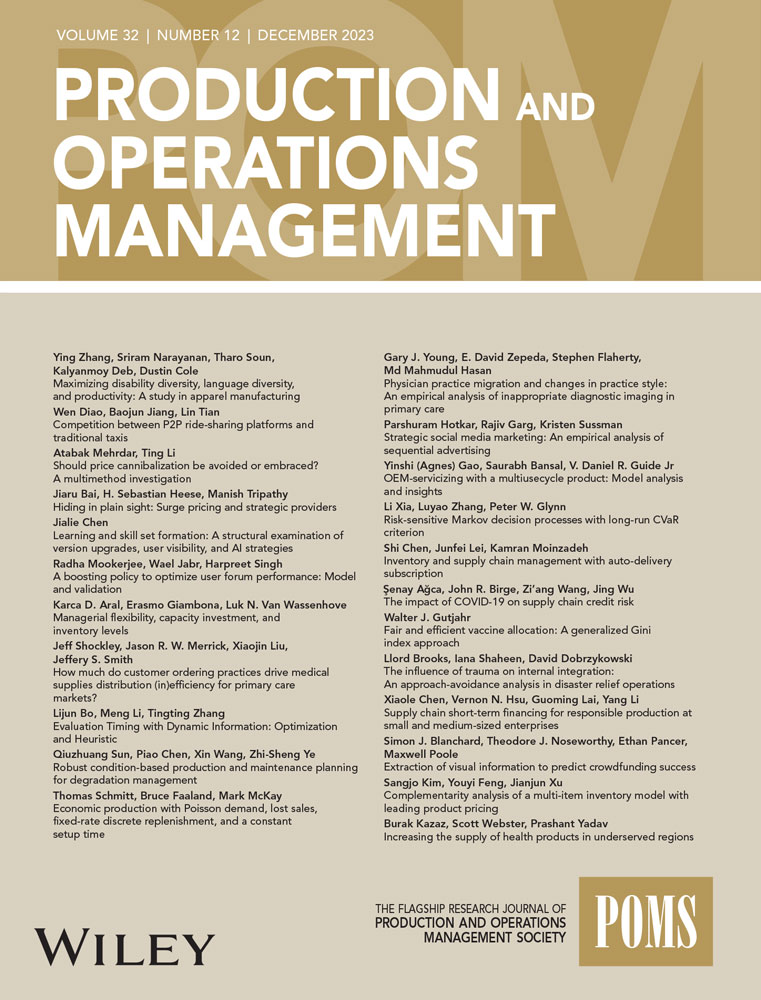Multiperiod channel coordination in franchise networks: The necessity of internal inventory trading and franchiser involvement
IF 5.1
3区 管理学
Q1 ENGINEERING, MANUFACTURING
引用次数: 0
Abstract
Facing consumers' growing demand for fast order fulfillment, it is important yet challenging for franchise companies to best incentivize frequent inventory sharing among their independent franchise retailers or dealers to achieve channel coordination. Past literature has only addressed such channel coordination for one-time inventory sharing using contractual agreements, which unfortunately do not work for frequent inventory sharing. In this study, we consider multiple inventory-sharing opportunities and propose a novel coordinating mechanism: internal inventory trading, enabled by disruptive IT platforms, such as the OneView platform's Inventory Management module (OVIM). On the OVIM, designed and operated by a brand (franchiser), every retailer (franchisee) can frequently access to all brand inventories virtually as they trade (buy or sell) inventory with one another and the brand. Using dynamic multiperiod games, we investigate how the brand should craft the trade rules and how the retailers should respond and trade periodically in equilibrium. We prove that channel coordination can be achieved in equilibrium, and the coordination requires both an internal inventory-trading platform and the brand's proactive involvement in trading as the rule and market maker. Specifically, the coordinating trade rules require the brand to (1) only profit from the royalties (not from trading), (2) set the coordinating trade prices (CTPs) to respond to the real-time channel inventory, and (3) let the buyer and the seller split shipping costs in any proportion, but not offering any subsidy. We provide a detailed characterization of the CTPs for each period, serving multiple purposes beyond simply removing double marginalization. When the channel inventory is high and imbalanced, the CTPs must include a trading reward to prevent retailers from strategically holding more or less inventory than the channel-optimal amount to “manipulate” future trade prices. The good news is that these CTPs are intuitive (constant or market-clearing) and can be automated into the trading platform ex ante. These actionable insights can guide franchise companies toward best utilizing their channel inventory and improving their profit and customer satisfaction.特许经营网络的多期渠道协调:内部库存交易和特许人参与的必要性
面对消费者对快速完成订单的日益增长的需求,特许经营公司如何最好地激励其独立特许零售商或经销商之间频繁的库存共享,以实现渠道协调,这是一个重要而又具有挑战性的问题。过去的文献只讨论了使用合同协议进行一次性库存共享的渠道协调,不幸的是,这种协议不适用于频繁的库存共享。在本研究中,我们考虑了多种库存共享机会,并提出了一种新的协调机制:内部库存交易,由颠覆性IT平台实现,如OneView平台的库存管理模块(OVIM)。在由品牌(特许经营商)设计和运营的OVIM上,每个零售商(特许经营商)可以经常访问所有品牌的库存,因为他们与彼此和品牌进行交易(买卖)库存。利用动态多期博弈,我们研究了品牌应该如何制定交易规则,以及零售商应该如何在均衡状态下周期性地做出反应和交易。我们证明了渠道协调是可以均衡实现的,而渠道协调既需要内部的库存交易平台,也需要品牌作为规则和做市商积极参与交易。具体来说,协调贸易规则要求品牌(1)只从版税中获利(不从贸易中获利);(2)根据实时渠道库存设定协调贸易价格(ctp);(3)让买卖双方按任意比例分摊运费,但不提供任何补贴。我们提供了每个时期ctp的详细特征,服务于多种目的,而不仅仅是消除双重边缘化。当渠道库存高且不平衡时,ctp必须包括交易奖励,以防止零售商策略性地持有比渠道最优数量更多或更少的库存,以“操纵”未来的贸易价格。好消息是,这些ctp是直观的(恒定或市场清算),可以事先自动进入交易平台。这些可操作的见解可以指导特许经营公司最好地利用他们的渠道库存,提高他们的利润和客户满意度。
本文章由计算机程序翻译,如有差异,请以英文原文为准。
求助全文
约1分钟内获得全文
求助全文
来源期刊

Production and Operations Management
管理科学-工程:制造
CiteScore
7.50
自引率
16.00%
发文量
278
审稿时长
24 months
期刊介绍:
The mission of Production and Operations Management is to serve as the flagship research journal in operations management in manufacturing and services. The journal publishes scientific research into the problems, interest, and concerns of managers who manage product and process design, operations, and supply chains. It covers all topics in product and process design, operations, and supply chain management and welcomes papers using any research paradigm.
 求助内容:
求助内容: 应助结果提醒方式:
应助结果提醒方式:


